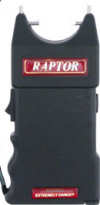 Actually, the penalty that freight forwarder Demetrios International Shipping recently agreed to pay was only $6,000, but it was for export of two Raptor 100K stun guns to Algeria without a license from the Bureau of Industry and Security (“BIS”). My apologies for the bad pun.
Actually, the penalty that freight forwarder Demetrios International Shipping recently agreed to pay was only $6,000, but it was for export of two Raptor 100K stun guns to Algeria without a license from the Bureau of Industry and Security (“BIS”). My apologies for the bad pun.
Stun guns, all of them, even those built by hobbyists from disposable cameras, are classified under ECCN 0A985 and require BIS licenses for exports to all destinations mostly because of concerns that they can be used as implements of torture. The Raptor 100k stun guns involved here, which retail at around $12 each, are relatively benign. Here’s an undeniably inane video (with some language that may not be safe for work) posted on YouTube by some dimwitted teenagers using a 100k stun gun on themselves to no apparent ill effect. These low end stun guns are probably not the first choice of Algerian police officers or Middle Eastern terrorists as implements of torture.
And, of course, it goes without saying that stun guns are readily available outside the United States. They are also easy to build from commonly-available electronic components using schematics readily available on the Internet. (WARNING: these schematics are controlled by ECCN 0E982. If you live outside the United States or are not a U.S. citizen or permanent resident, clicking the preceding link to those schematics will violate U.S. law and subject you to civil and criminal penalties, including imprisonment.)
Of course, none of these considerations are defenses to the violation by Demetrios. But it does suggest that there are good policy reasons for a review of ECCN 0A985 to restrict its application to stun guns that people might find, shall we say, more shocking.
 Permalink
Permalink
Copyright © 2008 Clif Burns. All Rights Reserved.
(No republication, syndication or use permitted without my consent.)

 Posted by
Posted by  Category:
Category: 

